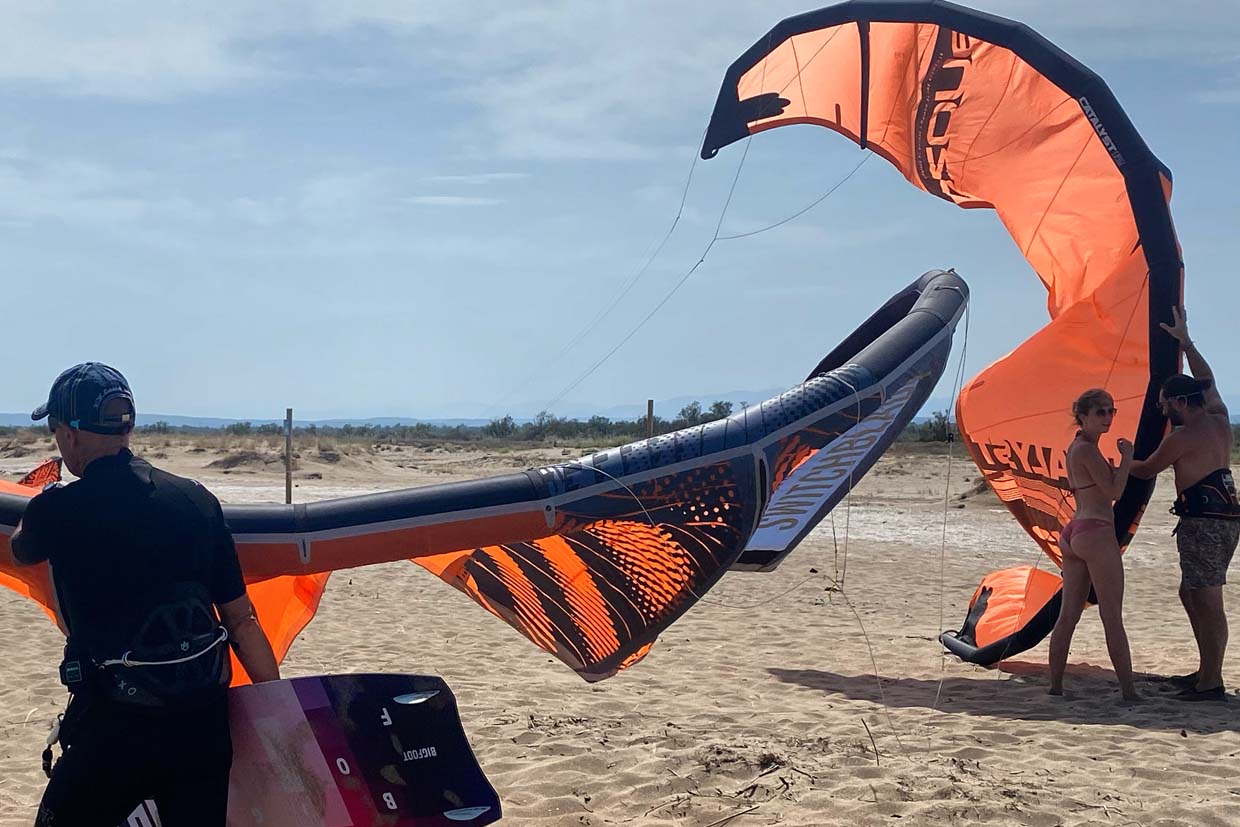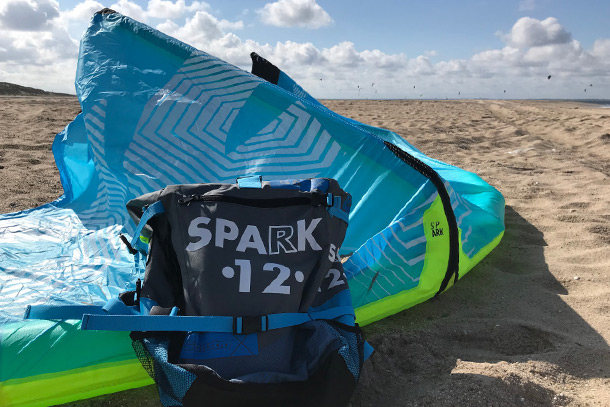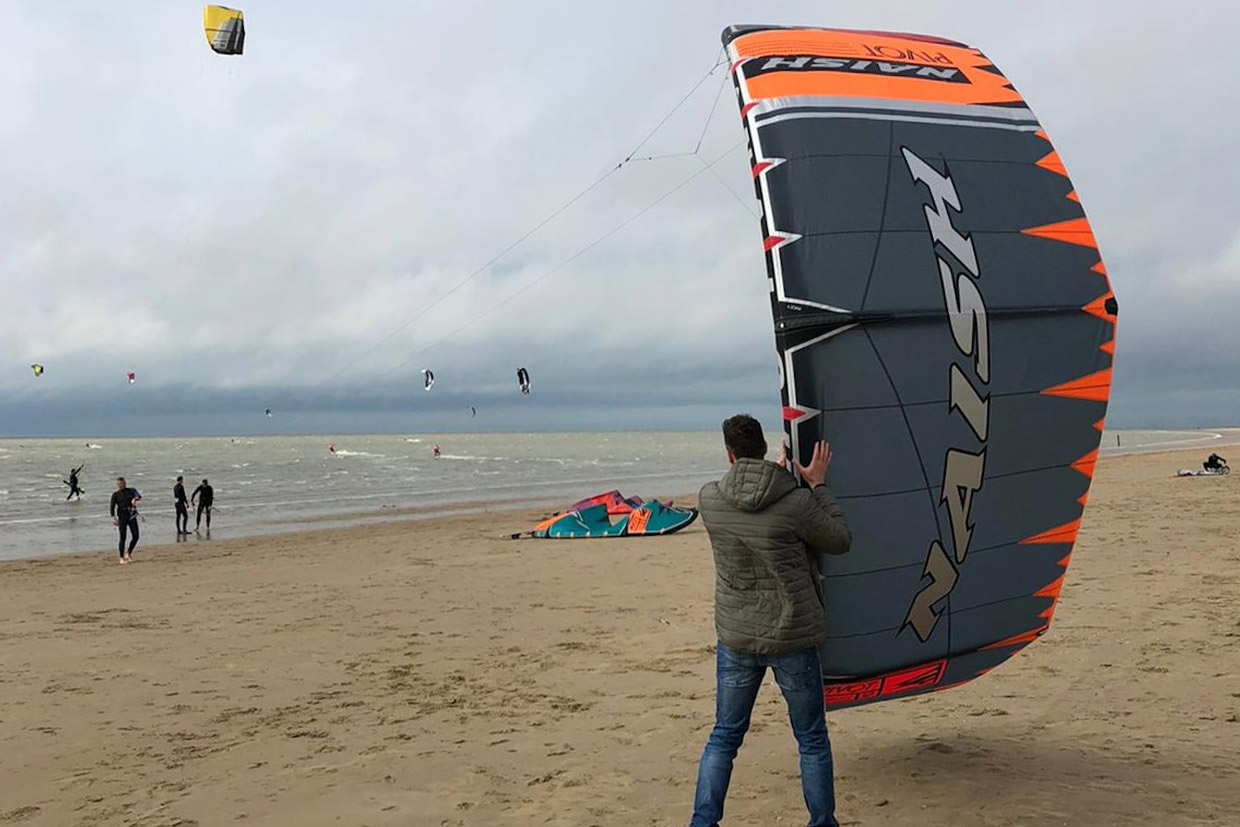Buying a second-hand kitesurfing set is quite smart. Not just when you're after you kitesurfing lesson want to work together with your buddy. But also if you have been kitesurfing for some time and are looking for a complete second-hand kitesurfing set on offer. We have already given you the following tips. First of all, how you know which kitesurf set suits you. Then a number of considerations before you buy a kitesurf occasion. In this very extensive informative kitesurfing blog we discuss inspecting a second-hand kite, kitebar and kiteboard. This way you know what to look out for if you want to buy second-hand kitesurfing equipment.
Table of contents
What should I pay attention to with second-hand kitesurfing equipment?
If you are planning to buy a second-hand kitesurfing set, there are several important things you should pay attention to to ensure that you make a good purchase and that the equipment is safe and of good quality. Here are some important generic considerations that we explain further in the blog below:

- Inspection of the kitesurfing equipment: Check the kites, bar, lines, harness, board and other accessories thoroughly for any damage or wear. Pay particular attention to tears, loose stitching, worn spots, and other signs of wear.
- Age of equipment: Kitesurfing equipment generally has a limited lifespan, especially kites. Check the age of the equipment and consider whether it is still worth using. Older kites may be less safe and may not meet the latest safety standards.
- repair and maintenance: Ask the seller if any repairs have been made to the equipment and if so, what type of repairs. Make sure any repairs have been done professionally and that there are no structural issues.
- Make and model: Research the make and model of equipment to ensure it is of good quality and suitable for your level and style of kitesurfing.
- Size of the kite: Make sure the size of the kite is suitable for your weight, experience and the wind conditions in which you plan to kitesurf. A kite that is too big or too small can be dangerous.
- Completeness of the set: Check that all necessary parts and accessories are included in the kit, such as the bar, lines, pump, repair kit and any other accessories.
- Pricing: Compare the price of the used set with the prices of comparable new sets and make sure you are paying a fair price based on the condition and age of the equipment.
- Seller reliability: Buy from a reliable seller with a good reputation. Ask for references or reviews from previous buyers if possible.
- Warranty: Check whether there is still a warranty left on the equipment and whether it is transferable to you as the new owner.
- Try it: If possible, try out the equipment before purchasing to make sure it works well and feels comfortable for you.
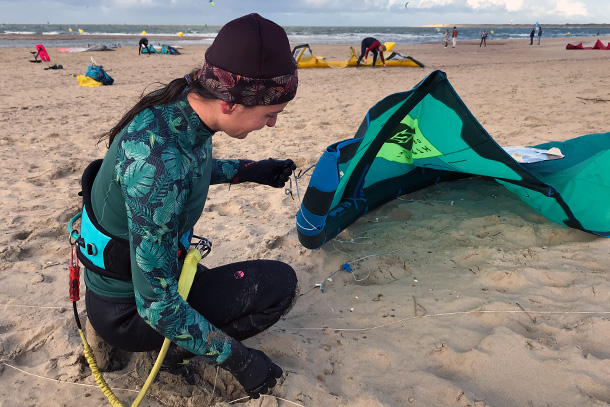
By considering these points, you can hopefully find a good second-hand kitesurfing set that suits your needs and is safe to use. Below we give specific tips for buying second-hand kitesurfing equipment.
Don't buy too old second-hand kitesurfing set
The technological development of kitesurfing is still in full swing. Every year the material becomes user-friendly, lighter, stronger and safer. We call this concept 'lite surfing' and write about it regularly. This means that you will probably enjoy kitesurfing better with the latest material of the type that suits you. In addition, the saying 'old age comes with defects' also applies to kitesurfing equipment. Examples: a valve whose glue comes loose when you inflate this kite, a kite bar whose grip rubber comes loose, a zipper of a kitesurfing bag that no longer works due to salt deposits.
This way you can find out more about second-hand kitesurfing equipment
- Search for the kitesurfing equipment that you want to buy second-hand via a search engine or on the site of the relevant kitesurfing brand. This way you can see whether this is suitable for you and whether it is not very outdated. For example, look up kitefinder.com.
- Search online for user manuals on the site of the kitesurf brand. These can often still be consulted and you can read more about the specific properties of the relevant kitesurfing equipment.
- Search online for reviews or user experience. These can tell you what the details are and what the experience of other kite surfers is. You can also ask a question on a kitesurf facebook group.
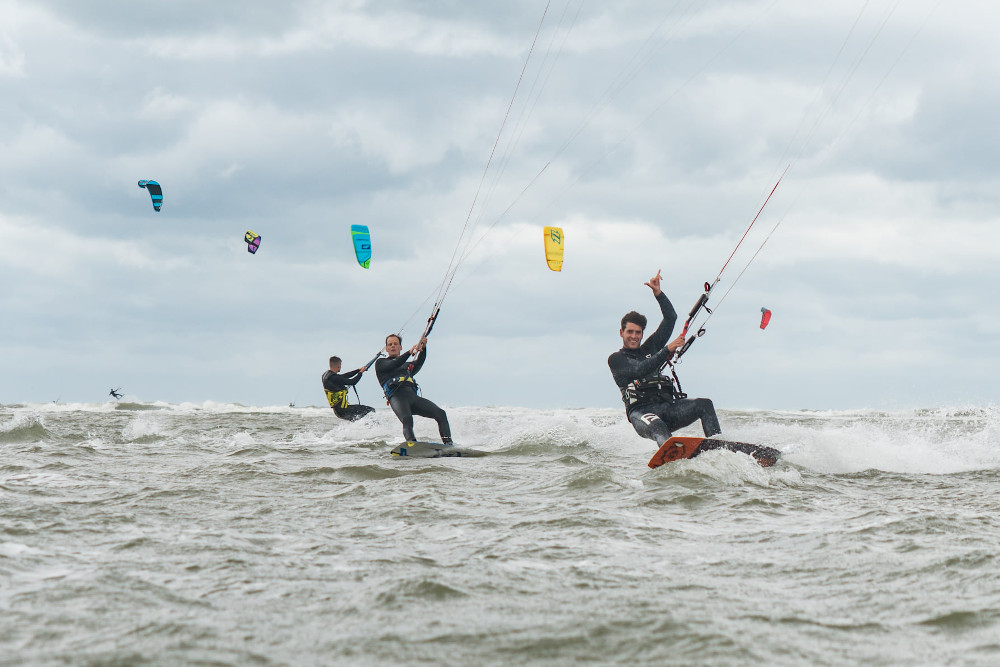
Buying a second-hand kite: what should I pay attention to?
You first look at the general condition of a kite. You can quickly see how the kite has been used. For example, the previous owner often stored it wet, stored it in a damp shed and / or let it flap for a long time in the wind. Then this is a completely different kite than that of an owner who has always stored his kite indoors, has always allowed it to dry and possibly rinsed with fresh water after a crash. You can see this on the kite. Also how it was dealt with. For example, a 3-month-old kite is completely worn out and a 3-year-old kite is still like new.
'For example, a 3-month-old kite is completely worn out and a 3-year-old kite is still like new.'
Also watch: What size kite do I need?
Overview of inspection points for buying a used kitesurf set
| New kite | ⇔ | Old kite |
|---|---|---|
| Cloth still crackles | ⇔ | Canvas is limp |
| Cloth still shines due to coating | ⇔ | Fabric is dull and with bare spots in the coating |
| Cloth is undamaged | ⇔ | Major repairs and patches have been made |
| Stitching still attached | ⇔ | Loose stitching and open seams |
| Lines on kite not frayed | ⇔ | Line on kite frayed or worn |
| Pulleys on the kite run smoothly | ⇔ | Pulleys are attached to the kite |
This is how you inspect a second-hand kite
- Inspect the kite thoroughly for the aforementioned points. You will not often encounter a second-hand kite without wear. You simply have wear and tear and will not stop with you.
- Features of an old kite as described above can be the precursor to larger defects that endanger your enjoyment and safety. Think about it carefully and if in doubt, consult with an expert.
- Pump up the kite and let it inflated for a while (15 min.) So that you are sure that this kite is not leaking.
- If you have the opportunity to test the kite, this is always recommended. Even if you can leave the kite on for a while to see that it is properly in the air. Also to make sure that the kite does not pull to one side. This could mean uneven lines but also indicate a problem with the kite. And just to experience whether this is the kite you are looking for.
Buying used kitebar: what should I pay attention to?
If you want to buy a second-hand kitesurf set, a good kite bar is just as important as a good kite. When we talk about a kitebar, this is the bar complete with lines and a well-functioning safety system. The latter is actually the most important and cannot / should not be cut back.
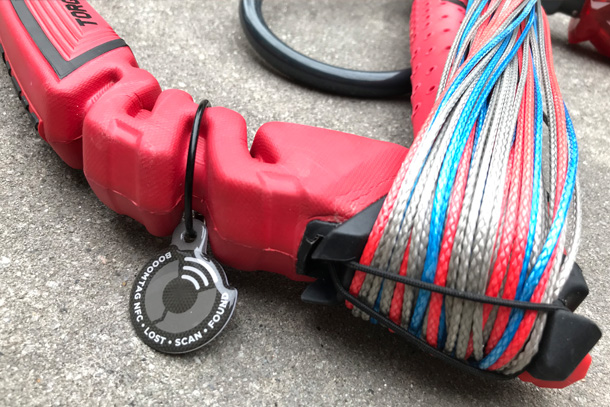
This is how you inspect a second-hand kite bar
- Buy a kitebar preferably suitable for your kite and from the same year as your kite. Then you know for sure that the kitebar is suitable for the kite.
- Run all the lines. Run this through your hands to make sure it is not damaged and has no knots. Knots greatly weaken kitesurfing lines and must be removed.
- Inspect the ends of the lines where you should tie them to the kite. If these are worn or cracked, they must be replaced.
- Inspect the depower line that runs through your bar. If it is made of rope and is worn, it should be replaced. Even if it has a PVC coating, still try to inspect the lines in it and at the ends.
- Inspect and test the safety system several times. Testing on the shore is of course different from under pressure and with tension on the lines on the water. It must work flawlessly on the bank. If necessary, look for information about the safety system online so that you can be sure that there have been no problems with it.
Buy a second-hand kiteboard
When buying a second-hand kiteboard there are several important points to pay attention to to ensure that you get a board that is suitable for your needs and is of good quality. Here are some things to keep in mind:
- Inspect the condition of the board: Check the board carefully for any damage, such as dents, cracks, scratches or repairs. The edges and bottom of the board in particular should be thoroughly inspected, as these areas often show wear.
- Material and construction: Pay attention to the material the board is made of and its construction. Kiteboards can be made of different materials such as wood, foam, epoxy or carbon. Each material has its own properties and advantages. Make sure the board is sturdy and durable.
- Size and shape: Kiteboards come in different shapes and sizes, depending on your preferences and the type of kitesurfing you want to do. Consider factors such as your weight, height, skill level and the conditions in which you will often kitesurf when choosing the right size and shape.
- Flexibility: Check the flexibility of the board by pressing it lightly. Good flexibility provides comfort and control while kitesurfing, but the board should not be too flexible to maintain stability.
- Bindings and inserts: Check that the bindings (foot straps) are in good condition and securely attached to the board. Make sure the inserts (the metal screw holes that the bindings attach to) are not damaged.
- Make and model: Research the brand and model of the board to ensure it is of good quality and suitable for your level and style of kitesurfing.
- Pricing: Compare the price of the used board to the prices of comparable new boards to ensure you are paying a fair price based on the condition and age of the board.
- Try it: If possible, try the board before you buy to see how it feels and performs on the water.
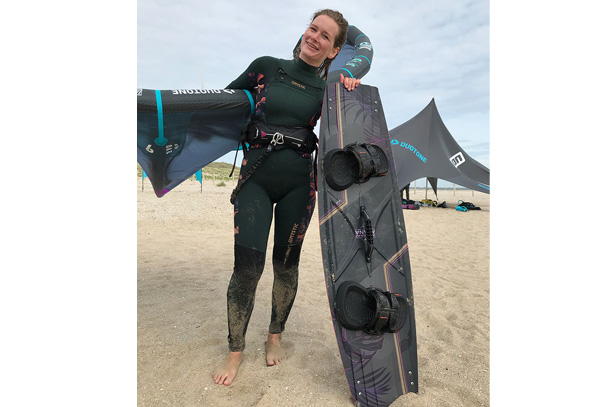
By considering these points, you can hopefully find a used kiteboard that suits your needs and is safe to use while kitesurfing.
Next steps to buy a kitesurf set
We have explained how to find out which kitesurf set is suitable for you. Then we got you thinking about kitesurfing occasions. In this kitesurf blog we have explained what you should pay attention to when purchasing if you decide to buy a second-hand kitesurf set. This can be done via one of the kitesurf shops but also, for example, via Marktplaats or one of the Facebook groups.
You can read more via the following link for the complete manual for purchasing a kitesurfing set. There you will also find an overview of the costs and price differences between a new and second-hand kitesurfing set or kitesurfing material.


